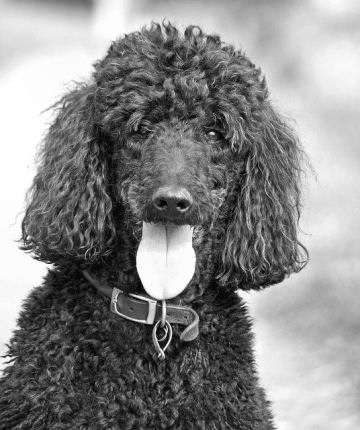It’s natural for people to protect small, young things. We have an instinct to take care of those more vulnerable. Don’t give in to it! Don’t let your dog hide!
Downsized dog

Hope is working now with a friend/student who has always had Sporting dogs; Weimeraners and Viszlas. She’s a bit older now and chose to “downsize” by getting a Miniature Poodle. It’s a wonderful choice for her, since Poodles are also Sporting dogs, originally bred as water retrievers. They’re also incredibly smart dogs.
Smart dogs will learn very fast what works for them and what they can get away with. If it works once, they’ll repeat it. If it keeps working, they’ll always do it.
Works for him
Our friend Sue, in addition to working with Hope, is also taking a pet-store puppy class with her four-month old Poodle Darwin. It’s the only current option, during the pandemic, for making sure her puppy is socialized to work with her in the presence of other dogs, people, and lots of distractions. It’s a good idea.
Sue was telling Hope how their class was going and reported that Darwin did great. He stayed under her chair and watched all the other, bigger puppies.
She was surprised when Hope let her know that was exactly the wrong thing to do.
Don’t let the puppy hide
It’s Sue’s first small dog and, like most adults, her first reaction is to take care of him and protect him from possible threats. But there was no threat – just other puppies.
Sue should have stood up, encouraged Darwin to move with her, and let him observe from a position next to her. We’re not saying he has to “dive in” to a puppy scrimmage, or charge into a new situation. But he does have to learn to trust that Sue won’t take him into danger and he can watch, assess, and still be safe without hiding.
A previous 2-Minute Tip addressed the very topic: “By rewarding fear, are you training your dog to be shy?”
Safe space
We advocate the use of crates for dogs for many reasons. One is that a crate should be the dog’s safe space. At dog shows and trials, you’d see almost every single dog competitor, when he/she isn’t showing, relaxing in a crate. It’s the “dressing room” where they can relax between appearances.
Hiding behind “mom” isn’t the same thing. The puppy isn’t relaxed and waiting. He/she is shy or tentative and using mom as protection. Allowed to continue, this can lead to lifelong timidity and even fear aggression. Some fearful dogs lunge out of their hidey-holes to attack anything that gets too close.
Sensible but not smart
It never occurred to Sue that letting Darwin hide underneath or behind her was a bad idea. She truly thought he was quite brilliant for seeking, and finding, “protection.” She was pleased when he came out to participate in the class lessons, and when he retreated back to his hidey-hole when the exercise was over.
It’ll take some conscious thought (and Hope’s nagging) to turn around Sue’s natural “mom” reaction to protect. Darwin is little and adorable. But in order to let her dog live his biggest possible life, she must learn that little dogs are still dogs. Hiding isn’t allowed. Exploring the world is good. And she’ll always be there to make sure nothing bad happens to him.
